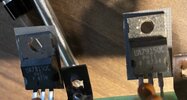Peter Mele
New Member
Hi all,
Forgive me for maybe being not the most adept with all this but I ned a little help. I've got a PSU for a Seck 1282 Mixing desk from the 80's and I'm trying to get to the bottom of why the fuse keeps blowing. I had it in storage for a few years and recently got it out to start using it once more and when plugging it in, the fuse pops...there are 2X2A quick blows.
So I searched the net and found the service manual (No luck on a replacement PSU though). It states that the fuses will blow if either of the Voltage regulators are faulty as Each regulator is on the 15V and 24V path. As both fuses are popping, I'm wondering if both regulators are faulty. I'm fairly novice at all this but I do have a basic grasp of electronics and as the desk is old (And left behind by an old friend who no longer wants it) I feel like I've nothing much to lose in having a go at fixing the PSU. In the picture you can see both regulators and I've found out that they are old Fairchild parts, I am in the dark as to how I find a modern equivalent. If I could swap them out with new ones, then at least I could eliminate them from enquiries...I've got no problems in the soldering side as I am always building Modular synth parts from kits etc, it's just wehn something goes wrong, I'm still learning about how to diagnose...I'd love to learn more though!
Thanks
Pete
Forgive me for maybe being not the most adept with all this but I ned a little help. I've got a PSU for a Seck 1282 Mixing desk from the 80's and I'm trying to get to the bottom of why the fuse keeps blowing. I had it in storage for a few years and recently got it out to start using it once more and when plugging it in, the fuse pops...there are 2X2A quick blows.
So I searched the net and found the service manual (No luck on a replacement PSU though). It states that the fuses will blow if either of the Voltage regulators are faulty as Each regulator is on the 15V and 24V path. As both fuses are popping, I'm wondering if both regulators are faulty. I'm fairly novice at all this but I do have a basic grasp of electronics and as the desk is old (And left behind by an old friend who no longer wants it) I feel like I've nothing much to lose in having a go at fixing the PSU. In the picture you can see both regulators and I've found out that they are old Fairchild parts, I am in the dark as to how I find a modern equivalent. If I could swap them out with new ones, then at least I could eliminate them from enquiries...I've got no problems in the soldering side as I am always building Modular synth parts from kits etc, it's just wehn something goes wrong, I'm still learning about how to diagnose...I'd love to learn more though!
Thanks
Pete



